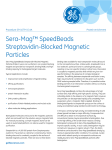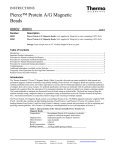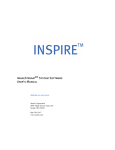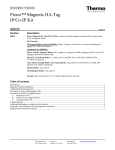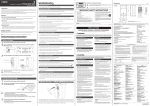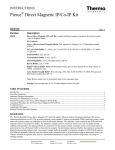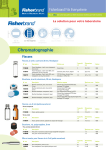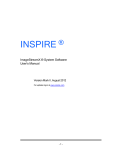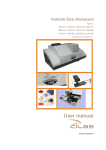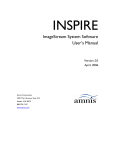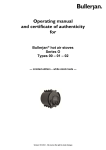Download Sera-Mag™ SpeedBeads Magnetic Protein A/G Particles
Transcript
Procedure 29-1079-14 AA Protein enrichment Sera-Mag™ SpeedBeads Magnetic Protein A/G Particles Sera-Mag SpeedBeads Protein A/G Magnetic Particles (Table 1) provide a fast and convenient method for both manual and automated magnetic isolation of proteins using affinity binding. The particles can be used for isolating antibodies from serum, cell culture supernatant or ascites, and for immunoprecipitation and co-immunoprecipitation of antigens from cell or tissue extracts. Bound antibodies or antigens are dissociated from the particles using an elution buffer. The particles can be manually removed from the solution using a magnetic stand, or by automation using automated magnetic particle handling systems. Table 1. Characteristics of Sera-Mag SpeedBeads Protein A/G Magnetic Particles Composition Recombinant protein A/G covalently coupled to particle surface Magnetization Superparamagnetic (no magnetic memory) Mean diameter 1 μm (nomimal) Concentration 10 mg/ml Binding capacity 55-85 μg IgG bound per mg of particle Particle density ~ 2.0 g/cm3 gelifesciences.com Sera-Mag SpeedBeads Protein A/G Magnetic Particles contain a recombinant Protein A/G (Mr ~50 500; apparent molecular weight by SDS-PAGE Mr ~40 000 to 45 000) that combines the IgG binding domains of both Protein A and Protein G. Protein A/G contains four Fc-binding domains from Protein A and two from Protein G, making it a more general and convenient tool for investigating and purifying immunoglobulins. Also, Protein A/G binding to immunoglobulins is not as pH-dependant as Protein A. Sera-Mag SpeedBeads Protein A/G particles are uniform, colloidally stable, monodispersed, non-porous superparamagnetic spheres made by a proprietary core-shell method. The core is a carboxylate-modified particle made by free radical emulsion polymerization of styrene and acid monomer. Two layers of magnetite (Fe3O4) are coated onto this core particle, resulting in faster magnetic response times. The surface is chemically modified with a proprietary method to minimize nonspecific binding of proteins. Finally, Protein A/G is covalently bound to the particle surface. The particles are supplied at 1% solids (10 mg/ml) in 0.05 % sodium azide and are available in 1 ml, 5 ml and 100 ml package sizes. Important information before using Sera-Mag SpeedBeads Protein A/G Magnetic Particles • Do not centrifuge, dry or freeze the magnetic particles. Centrifuging, drying or freezing will cause the particles to aggregate and lose binding activity. • We recommend thoroughly mixing (vortex, roll or sonicate) magnetic protein A/G particles before use. Sonication is the preferred method to resuspend the particles thoroughly and efficiently. • Sonication with a probe type ultrasonicator is recommended to resuspend particles after long term storage, and washing steps. • Neutralization buffer: High-ionic strength alkaline buffer such as a 1 M phosphate or 1 M Tris; pH 7.5-9. • Magnetic stand (e.g., MagRack 6, GE Healthcare code number 28-9489-64). Antibody purification from serum, cell culture supernatant, or ascites Note: To ensure homogeneity, mix the particles thoroughly before use by repeated inversion, gentle vortexing or using a rotating platform. 1. Place 50 μl (0.50 mg) of Sera-Mag SpeedBeads Protein A/G Magnetic Particles into a 1.5 ml microcentrifuge tube. Add 150 μl of binding/wash buffer to the particles and gently vortex to mix. • To minimize protein degradation, include protease inhibitors in preparation of cell lysates. 2. Place the tube into a magnetic stand to collect the particles against the side of the tube. Remove and discard the supernatant. • A low-pH elution may be used for single-use applications. Optimal time for low-pH elution is 10 min. Exceeding 10 min may result in nonspecific binding and yield reduction. 3. Add 1 ml of binding/wash buffer to the tube. Invert the tube several times or gently vortex to mix for 1 min. Collect particles with magnetic stand, then remove and discard the supernatant. • When using rabbit antibodies (primary or secondary) in downstream Western blot applications, perform elution in SDS-PAGE sample buffer at room temperature. For all other antibody species, boiling the particles in SDS-PAGE sample buffer is acceptable for single-use applications. Boiling will cause particle aggregation and loss of binding activity. 4. Dilute 10 μl of sample with 490 μl binding/wash buffer. • Sera-Mag SpeedBeads Protein A/G Magnetic Particles are compatible with small-scale antibody purification and immunoprecipitation and analyses by Western blot and mass spectrometry. Procedure for manual antibody purification Additional materials required • 1.5 ml microcentrifuge tubes. • Sample: serum, concentrated cell culture supernatant or concentrated ascites. • Binding/Wash buffer: Tris-buffered saline (25 mM Tris, 0.15 M NaCl, pH 7.5) containing 0.05 % Tween™-20 detergent. • Elution buffer: 0.1 M glycine, pH 2-3. 2 29-1079-14AA Note: Sample volume can be modified according to user preference. If the sample volume is < 500 μl dilute it to a final volume of 500 μl with binding/wash buffer. 5. Add the diluted sample to the tube containing prewashed magnetic particles and gently vortex or invert to mix. 6. Incubate the samples at room temperature with mixing for 1 h. 7. Collect the particles with a magnetic stand, then remove and discard the supernatant. 8. Add 500 μl of binding/wash buffer to the tube, mix well, collect the particles with a magnetic stand and discard the supernatant. Repeat this wash twice. 9. Add 100 μl of elution buffer to the tube, mix well and incubate 10 min at room temperature with occasional mixing. 10. Collect the particles with a magnetic stand and then remove and save the supernatant that contains the eluted antibody. To neutralize the low pH, add 10 μl of neutralization buffer for each 100 μl of eluate. Note: 50 μl is the minimum volume of particles recommended for antibody purification. Procedure for automated antibody purification Notes • If using less than 96 wells, fill the same wells in each plate. For example, if using wells A1 through A12, use these same wells in all plates. Additional materials required • KingFisher™ Flex with 96 Deep Well head (Thermo Scientific product number 5400630) or KingFisher 96 (Thermo Scientific product number 5400500). • KingFisher Flex Microtiter Deepwell 96 plate, V-bottom (Thermo Scientific product number 95040450). • KingFisher Flex 96 tip comb for Deep Well Magnets (Thermo Scientific product number 97002534). • Binding/wash buffer: Tris-buffered saline containing 0.05% Tween-20 detergent). • To ensure bead homogeneity, mix the vial thoroughly by repeated inversion, gentle vortexing or rotating platform before adding the particles to plate 1. • Combine the Tip Comb with a Deep Well 96 plate. See KingFisher Flex or KingFisher 96 user manual for detailed instructions. • Sample volume can be modified according to user preference. If the sample volume is < 500 μl dilute it to a final volume of 500 μl with binding/wash buffer. Executing the antibody purification protocol on the KingFisher Flex • Elution buffer: 0.1 M glycine, pH 2-3. • Neutralization buffer: High-ionic strength alkaline buffer such as a 1 M phosphate or 1 M Tris; pH 7.5-9. Preparation of instrument and plate set-up Note: The following protocol is designed for general use with the KingFisher Flex or KingFisher 96 Instrument. The protocol can be modified according to customer needs using the Thermo Scientific BindIt™ software provided with the instrument. 1. Download the “Antibody Purification” protocol from the Thermo Fisher Scientific website (www.thermoscientific.com/ kingfisher) into the BindIt software on an external computer. 2. Transfer the protocol to the KingFisher Flex or KingFisher 96 from an external computer. See BindIt Software User Manual for detailed instructions on importing protocols. 3. Set up the plates according to Table 2. 1. Select the protocol using the arrows on the instrument key pad and press Start. See KingFisher Flex User Manual for detailed information. 2. Slide open the door of the instrument’s protective cover. 3. Load the plates into the KingFisher Flex according to the protocol request, placing each plate in the same orientation. Confirm each action by pressing Start. 4. After the samples are processed, remove the plates as instructed by the instrument’s display. Press Start after removing each plate. 5. Press Stop after all plates are removed. 6. Upon completion, if desired, neutralize the low pH by adding 10 μl of neutralization buffer for each 100 μl of eluate. Table 2. Pipetting Instructions for the Antibody Protocol Using the Microtiter Deep Well 96 Plates Plate Plate # Name Content Volume 1 Particles Protein A/G particles Binding/Wash buffer 50 μl 150 μl 2 Particle wash Binding/Wash buffer 1000 μl 3 Bind Sample Binding/Wash buffer 10 μl 490 μl 4 Wash 1 Binding/Wash buffer 500 μl 5 Wash 2 Binding/Wash buffer 500 μl 6 Wash 3 Binding/Wash buffer 500 μl 7 Elution Elution buffer 100 μl Tip plate KingFisher Flex 96 tip comb for Deep Well magnets 8 - 29-1079-14AA 3 Procedure for manual immunoprecipitation (IP) 7. Collect the particles with a magnetic stand and then remove the flow-through and save for analysis. Additional materials required 8. Add 500 μl of wash buffer to the tube and gently mix. Collect the particles and then discard the supernatant. Repeat this wash twice. • 1.5 ml microcentrifuge tubes. • Binding buffer: Tris-buffered saline (25 mM Tris, 0.15 M NaCl, pH 7.5) containing 0.05% Tween-20 detergent. • Wash buffer: 25 mM Tris, 0.65 M NaCl, 0.05% Tween-20 detergent, pH 7.5. • Low-pH elution buffer: 0.1 M glycine, pH 2-3. • Alternative elution buffer: SDS-PAGE reducing sample buffer. • Antibody for immunoprecipitation. • Antigen sample. • Cell lysis buffer (used to adjust IP reaction volume). • Neutralization buffer: High-ionic strength alkaline buffer such as a 1 M phosphate or 1 M Tris; pH 7.5-9. Immunoprecipitation Note: This protocol is a general guideline for immunoprecipitation and will require optimization for each application. 1. Combine the antigen sample with 10 μg of antibody. Adjust the reaction volume to 500 μl with the cell lysis buffer. Incubate the reaction for 1 to 2 h at room temperature or overnight at 4ºC with mixing. 2. Place 25 μl (0.25 mg) of Sera-Mag SpeedBeads Protein A/G Magnetic Particles into a 1.5 ml microcentrifuge tube. 3. Add 175 μl of wash buffer to the particles and gently vortex to mix. 4. Place the tube into a magnetic stand to collect the particles against the side of the tube. Remove and discard the supernatant. 5. Add 1 ml of wash buffer to the tube. Invert the tube several times or gently vortex to mix for 1 min. Collect particles with magnetic stand. Remove and discard the supernatant. 6. Add the antigen sample/antibody mixture to a 1.5 ml microcentrifuge tube containing prewashed particles and incubate at room temperature for 1 h with mixing. 4 29-1079-14AA 9. Add 500 μl of purified water to the tube and gently mix. Collect the particles on a magnetic stand and discard the supernatant. 10. Low-pH Elution: Add 100 μl of low-pH elution buffer to the tube. Incubate the tube at room temperature with mixing for 10 min. Magnetically separate the particles and save the supernatant containing target antigen. To neutralize the low pH, add 10 μl of neutralization buffer for each 100 μl of eluate. Alternative elution: Add 100 μl of SDS-PAGE reducing sample buffer to the tube and heat the samples at 96°C to 100ºC in a heating block for 10 min. Magnetically separate the particles and save the supernatant containing target antigen. Note: If you will be performing a Western blot using rabbit antibodies (primary or secondary) do not heat the samples. Incubate at room temperature for 10 min with mixing. Procedure for automated immunoprecipitation Additional materials required • KingFisher Flex with 96 Deep Well head (Thermo Scientific product number 5400630) or KingFisher 96 (Thermo Scientific product number 5400500). • KingFisher Flex Microtiter Deepwell 96 plate, V-bottom (Thermo Scientific product number 95040450). • KingFisher Flex 96 tip comb for Deep Well magnets (Thermo Scientific product number 97002534). • 1.5 ml microcentrifuge tubes. • Binding buffer: Tris-buffered saline containing 0.05 % Tween-20 detergent. • Wash buffer: Tris-buffered saline containing 0.05 % Tween-20 detergent and 0.5 M NaCl. • Low-pH elution buffer: 0.1 M glycine, pH 2-3. • Alternative elution buffer: SDS-PAGE reducing sample buffer. • Antigen sample. • Cell lysis buffer (used to prepare the antigen sample). Notes • Neutralization buffer: High-ionic strength alkaline buffer such as a 1 M phosphate or 1 M Tris; pH 7.5-9). • If using less than 96 wells, fill the same wells in each plate. For example, if using wells A1 through A12, use these same wells in all plates. • Magnetic stand (e.g., MagRack 6, GE Healthcare code number 28-9489-64). Instrument preparation and plate set-up Note: The following protocol is designed for general use with the KingFisher Flex or KingFisher 96 Instrument. The protocol can be modified according to your needs using the BindIt Software provided with the instrument. 1. Combine antigen sample with 2-10 μg of immunoprecipitation antibody per sample. Incubate 1-2 h at room temperature or overnight at 4ºC with mixing. 2. Enter the “Immunoprecipitation” protocol from Table 3 into the BindIt Software on an external computer. 3. Transfer the protocol to the KingFisher Flex or KingFisher 96 from an external computer. See BindIt Software User Manual for detailed instructions on importing protocols. Table 3. Pipetting instructions for the immunoprecipitation protocol using the Microtiter Deep Well 96 Plates Content Volume Time/Speed Protein A/G particles Binding buffer 50 μl 150 μl 5s 1000 μl 1 min/slow 1 Particles 2 Particle wash Binding buffer 3 Bind Antibody/ Antigen sample 500 μl 1 min/slow 4 Wash 1 Binding/Wash buffer 500 μl 30 s/slow 5 Wash 2 Binding/Wash buffer 500 μl 30 s/slow 6 Wash 3 Ultrapure water 500 μl 30 s/slow 7 Elution Elution buffer 100 μl 10 min/slow Tip plate KingFisher Flex 96 tip comb for Deep Well magnets - 10 min/fast 8 • Combine the Tip Comb with a Deep Well 96 plate. See KingFisher Flex or KingFisher 96 user manual for detailed instructions. • The particles can be eluted into 100 μl of 0.1 M glycine, pH 2-3 or 100 μl SDS-PAGE reducing sample buffer. If using SDSPAGE reducing sample buffer in a heated elution, install the KingFisher Flex or 96 Heating Block (see manual for proper installation) to heat samples at 96°C to 100ºC for 10 min. • If you select SDS-PAGE reducing sample buffer for elution and will be performing a Western blot using rabbit antibodies (primary or secondary), do not heat the samples. Incubate at room temperature for 10 min. • If low-pH elution buffer is selected for elution, neutralize the pH using 10 μl neutralization buffer for each 100 μl of eluate upon run completion. 4. Set up plates according to Table 3. Plate Plate # name • To ensure particle homogeneity, mix the vial thoroughly by repeated inversion, gentle vortexing or rotating platform before adding the particles to plate 1. • To limit evaporation, select “Mix” and “Slow” speed under the subheading “Heating Action”. 29-1079-14AA 5 Executing automated immunoprecipitation protocol 1. Select the protocol using the arrows on the instrument key pad and press Start. See the KingFisher Flex User or Kingfisher 96 User Manual for detailed information. 2. Slide open the door of the instrument’s protective cover. 3. Load the plates into the instrument according to the protocol request, placing each plate in the same orientation. Confirm each action by pressing Start. 4. After the samples are processed, remove the plates as instructed by the instrument’s display. Press Start after removing each plate. Press Stop after all the plates are removed. Troubleshooting General troubleshooting tips and suggestions for Sera-Mag Speedbeads Protein A/G Magnetic Particles: Problem Possible Cause Solution Low amount of protein was recovered The protein degraded Insufficient magnetic particles used Insufficient target protein present in sample Add protease inhibitors Increase the amount of magnetic particles used for capture Increase amount of antigen sample Protein does not elute Elution conditions are too mild Increase incubation time with elution buffer or use more stringent elution buffer Bands at Mr 50 000 appear on Western blot Elution conditions are too stringent Perform elution at room temperature Multiple, nonspecific bands appear in eluted sample Nonspecific protein binding to the magnetic particles Add 50-200 mM NaCl to the binding/wash and/or elution buffers Recovered protein was inactive Elution conditions are too stringent Use a milder elution buffer Magnetic particles aggregate Magnetic particles were frozen or centrifuged Buffer is incompatible with magnetic particles Handle the particles as directed in the instructions 6 29-1079-14AA 29-1079-14AA 7 GE and GE monogram are trademarks of General Electric Company. Sera-Mag is a trademark of General Electric Company or one of its subsidiaries. Tween is a trademark of the Croda Group of Companies. KingFisher is a trademark of Thermo Fisher Scientific LLC. All other third party trademarks are the property of their respective owners. For local office contact information, visit: www.gelifesciences.com/contact www.gelifesciences.com/sera-mag GE Healthcare UK Limited Amersham Place Little Chalfont, Buckinghamshire, HP7 9NA, UK © 2011–2014 General Electric Company - All rights reserved. Previously published Sept. 2011 All goods and services are sold subject to the terms and conditions of sale of the company within GE Healthcare which supplies them. A copy of these terms and conditions is available on request. Contact your local GE Healthcare representative for the most current information. GE Healthcare Bio-Sciences AB Björkgatan 30 751 84 Uppsala Sweden GE Healthcare Europe, GmbH Munzinger Strasse 5 D-79111 Freiburg Germany GE Healthcare Bio-Sciences Corp. 800 Centennial Avenue, P.O. Box 1327 Piscataway, NJ 08855-1327 USA GE Healthcare Japan Corporation Sanken Bldg., 3-25-1 Hyakunincho Shinjuku-ku Tokyo 169-0073 Japan 29-1079-14AA 06/2014








